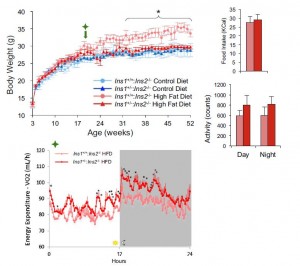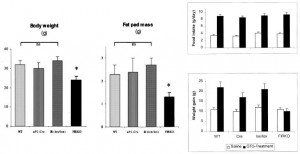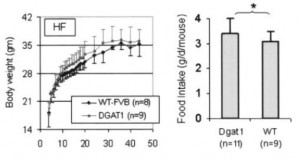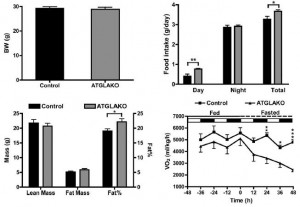The Laws of Energy Balance are always maintained. Here are some insights into how this is accomplished from a mouse perspective. A hormonal milieu which is unfriendly for fat storage will make you lean, but not by magic. We’ve got: 1) reduced food intake; and/or 2) increased energy expenditure.
Recall the faux-low carb mouse (Ins1+/-; Ins2-/- aka InsKO; Mehran et al., 2012). They can’t get fat because of an inability to develop hyperinsulinemia. Food intake isn’t reduced, so energy expenditure goes up. Since the fat isn’t stored, it needs an “out,” so it either inhibits food intake or ramps up energy expenditure; InsKO gives us the latter.
While not hormonally-mediated, PPARg+/- mice can’t get fat because of defective adipogenesis and they handle this problem both ways; by reducing food intake and increasing energy expenditure (Kubota et al., 1999). Similar to InsKO, PPARg+/- have lower insulin, but the primary defect in these mice is defective adipogenesis. They can’t store fat, so this unstored fat: 1) tells the brain there’s plenty of fuel around so stop eating; and 2) ramps up energy expenditure to burn itself off:
FIRKO (Fat-Specific Insulin Receptor KnockOut) mice can’t get fat because insulin receptors have been genetically removed from adipose (Bluher et al., 2003). Similar to InsKO, FIRKO eats just as much but weighs markedly less. And although energy expenditure wasn’t measured, it likely went up (not the only interpretation I can think of, but a highly probable one). They also have lower insulin levels (see a trend here?), but the primary defect is insulin signaling if adipose.
On the flipside,
Mice with adipose-specific DGAT1 overexpression are genetically predisposed to store more fat (Chen et al., 2005). As such, they are forced to overeat to grow their fat tissue:
(and unlike the lean mice mentioned above, these heavier guys have higher insulin levels).
Mice with a genetic inability to release fat from adipose, (ATGLAKO, Adipose Triacylglycerol Lipase Adipose-specific KnockOut) exhibit a similar phenotype (Wu et al., 2012). While they don’t weigh much more, they have a higher body fat % (they’re fattier); and since they can’t access stored fat, they eat more and move less to compensate.
What does all this mean?
1) Ein = Eout, but it’s not all about calories. Any situation where fat storage is unfavorable (eg, InsKO, PPARg+/-, FIRKO, low carb diets) will result in decreased food intake and/or increased energy expenditure to balance total fuel availability. And any situation where fat storage is favorable (eg, DGAT1 Tg, ATGLAKO) will result in increased food intake and/or decreased energy expenditure to balance fuel availability. It’s not all about food intake. Factors which alter fat storage capacity, where the primary effect begins at adipose, will affect food intake and/or energy expenditure accordingly.
Dieting won’t make you skinny if energy expenditure goes down. You can get fat without eating more if energy expenditure goes down. If the hormonal milieu favors fat storage (eg, insulin), you’ll gain fat mass regardless of whether it is by eating more or moving less. Increased metabolic rate won’t result in fat loss if you’re eating more. Obese patients have higher metabolic rates than lean people; they’re obese because they eat more. And last but not least (and possibly most), body composition matters – ATGLAKO mice aren’t heavier, but they are fattier. The Laws of Energy Balance are always maintained.

